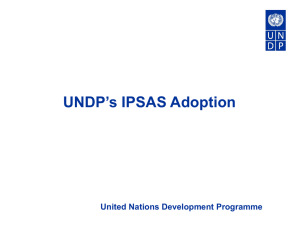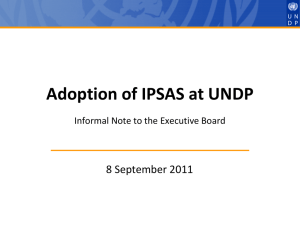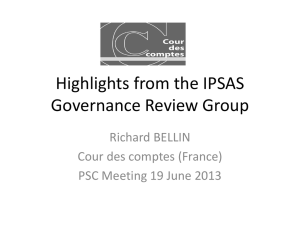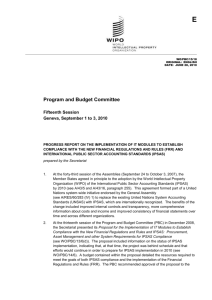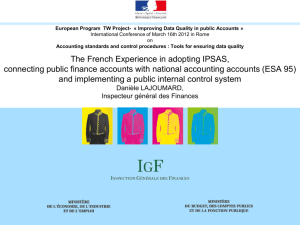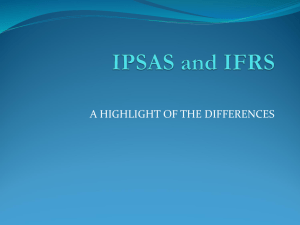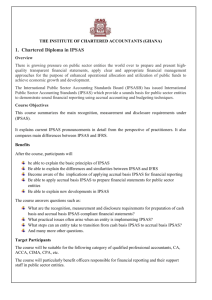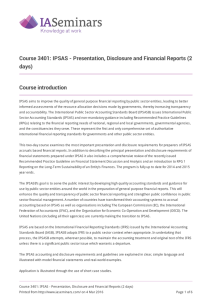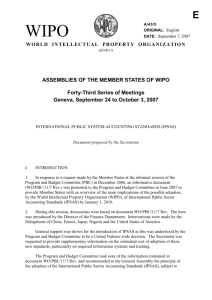IPSAS Adoption Progress
advertisement
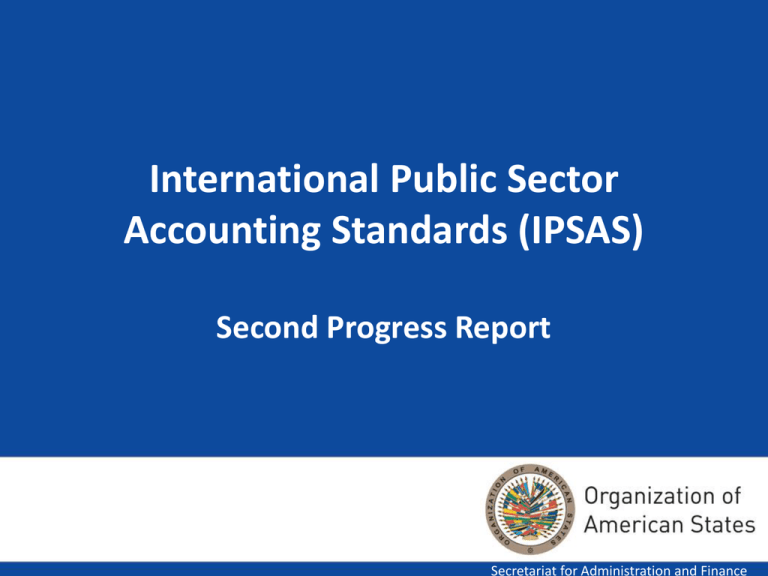
International Public Sector Accounting Standards (IPSAS) Second Progress Report 1 Secretariat for Administration and Finance Introduction Introduction -CAAP’s request for a progress report -SAF presented its first progress report March 25, 2011 document CP/CAAP-3100/11 -SAF presents its second progress report March 14, 2014 document CP/CAAP-3288/14 Presentation format -IPSAS overview -Adoption progress 2007 – 2010 -Adoption progress 2011 – present -Going forward 2 What is IPSAS and Why is it required? • International Public Sector Accounting Standards (IPSAS) are a set of independently produced financial reporting standards. • Improved consistency, comparability and reliability of financial statements. • Opportunity to enhance oversight and internal control. • Increased transparency with respect to assets and liabilities. • More comprehensive information about costs. • Higher level of accountability and governance through improved financial reporting. 3 Who Benefits by Adopting IPSAS? • Donors and Member States: Higher confidence in the financial reports and increased assurance of efficient resource utilization. • Beneficiaries: Improved efficiencies in resource management and effectiveness of operational delivery. • Management: Better insight in terms of resources needs and uses as well as liabilities, leading to a basis for improved financial and operational decision making. • Program Managers: Enhanced knowledge of existing resources. 4 What does IPSAS Require? There are two important components to keep in mind regarding IPSAS: • Basis of Accounting: IPSAS are financial reporting standards for the presentation of financial statements prepared on accrual basis of accounting. • Output to which IPSAS applies: IPSAS applies to presentation of transactions and events reported in General Purpose Financial Statements (GPFR) 5 Basis of Accounting • Accrual basis: the performance of an entity is measured by recognizing economic events when they occur regardless of when cash transactions occur. • Cash basis: revenue and expenses are recognized at the time when physical cash is received or paid out regardless of when the economic event occurs. • Currently the General Secretariat follows a modified cash basis: • cash basis of accounting • some long term assets/liabilities are recorded under accrual basis • notes disclose items that should be reflected in financial statements. • Most public sector organizations historically have maintained their accounting records on the cash basis; however, now, more public sector organizations are implementing accrual basis accounting and IPSAS based financial statements. 6 IPSAS Output: General Purpose Financial Reports • IPSAS applies to the presentation of General Purpose Financial Reports (GPFR) • GPFR are consolidated financial statements that include all those entities under the control of the primary entity (OAS). • GPFR are issued for users who are unable to demand financial information to meet their specific information needs. • GPFR are prepared and audited once a year for the fiscal year. • IPSAS does not provide guidance for budget execution. It requires an annual comparison of budget and actual amounts either as separate financial statements or as a budget column in the financial statements. IPSAS does require a reconciliation between the cash budget and the accrual statements. 7 IPSAS Output: General Purpose Financial Reports IPSAS adoption will change the number of annual financial statements, their structure and content. Below 6 major components: GS/OAS Assets, liabilities and fund balances IPSAS Statement of financial position Statement of financial performance Changes in Fund Balance Statement of changes in net assets Liquidity Risk Assessment Other Funds presented under U.S. GAAP Cash flow statement Budget Execution Report Statement of comparison of budget and actual amounts Notes to the financial statements Notes to the financial statements – More detail and additional disclosures required 8 IPSAS Adoption Progress: 2007 – 2010 • Gap Analysis: in 2007, the General Secretariat contracted an external firm to conduct a gap analysis between current OAS accounting practices and IPSAS requirements. • Training: In 2008, a three-day IPSAS workshop was delivered at PAHO and included some Finance staff of the OAS General Secretariat. In 2010, 11 computer based training sessions and 18 instructor - led training courses were provided to various General Secretariat staff. • Business processes: in 2008, an external firm was contracted to document current business processes at the General Secretariat, as preliminary work to begin drafting new and revised business processes to comply with IPSAS requirements. 9 IPSAS Adoption Progress: 2007 – 2010 • Project analysis: the General Secretariat drafted an initial high-level project plan showing phases required for IPSAS adoption and a proposed budget for implementation. • First progress report provided to CAAP: the activities presented above were presented to CAAP March 25, 2011 (document No. CP/CAAP-3100/11). The report also included high level implementation phases, a timelines and related costs. No funds were allocated to the project and no follow-up mechanism was established. 10 IPSAS Adoption Progress: 2011 – Present • Creation of the IPSAS steering committee: required so it will approve the goals, objectives and action plan for the adoption of IPSAS. It includes: • The Secretary of Administration and Finance • Director of Legal Services • Advisors to the Secretary General • Inspector General (Observer) The committee must be flexible to shrink or expand depending on needs. • Implementation of new subsystems: GS/OAS has begun changing some of its business processes though the implementation of modules or subsystems that interface with OASES (LMS, TECs, RBCS). • Change in Policy: Updated fixed asset policy-more complete, increased capitalization threshold, includes additional IPSAS requirements. 11 IPSAS Adoption Progress: 2011 – Present • Updated IPSAS online training for SAF personnel: the United Nations prepared a seven-module online IPSAS training program. During the last quarter of 2013, over 50 SAF personnel took these self-guided courses, receiving a certificate of completion at the end of each course. • Updated IPSAS self-guided training for SAF personnel: there are additional self-guided trainings taken by various staff within SAF that was prepared by an external consultant on more profound IPSAS concepts. 12 IPSAS Adoption Progress: 2011 – Present • Meeting with Pan American Health Organization: meeting of accounting departments in late 2013 to discuss their lessons learned during and after the adoption. • From the meeting with PAHO, the General Secretariat learned the following: • PAHO’s budget included an annual appropriation of funds of approximately $300 thousand throughout the implementation • PAHO’s administration designated 6 fully dedicated finance staff (out of 60 financial staff) to implement IPSAS • It took PAHO approximately 4 years to become IPSAS compliant after receiving funding 13 Challenges to Achieving Further Progress •IPSAS adoption and implementation most usually takes longer than 5 years to achieve. •IPSAS itself recognizes the complexity of implementing the standards and allows up to five years from initial production of otherwise IPSAS-compliant GPFRs to achieve full compliance. •UN System organizations’ implementation of IPSAS are nearly always programmed simultaneous with major improvements in, or replacement of, legacy information management systems. •Implementation of IPSAS is resource intensive. •IPSAS requirements go beyond the Finance Department and the Secretariat for Administration and Finance; it involves all staff of the General Secretariat. 14 Going Forward • Although the General Secretariat has engaged in various mixed activities in preparation of adopting IPSAS, for the organization to move forward, additional funding and time is required. • A roadmap for becoming IPSAS compliant is needed to identify the sequential milestones that need to be attained, the amount of financial and human resources required, and a realistic timeline. • The General Secretariat is preparing a project profile following the guidelines of the Department of Planning and Evaluation and for final submittal to the Project Evaluation Committee. 15 Going Forward The project profile will include the following components: • Logical framework, frame of reference and project description. • Calendar of activities (i.e., roadmap that will allow a sequential implementation). • Implementation timeline identifying required milestones, including the year in which the OAS will present IPSAS compliant financial statements • Estimated budget identifying human and financial resources. • Project component for monitoring and evaluation. Once the project document is finished by the end of May, the General Secretariat will have a better sense of funding and timeline requirements. The document will also serve as a tool to attract external funding for the project implementation. 16

